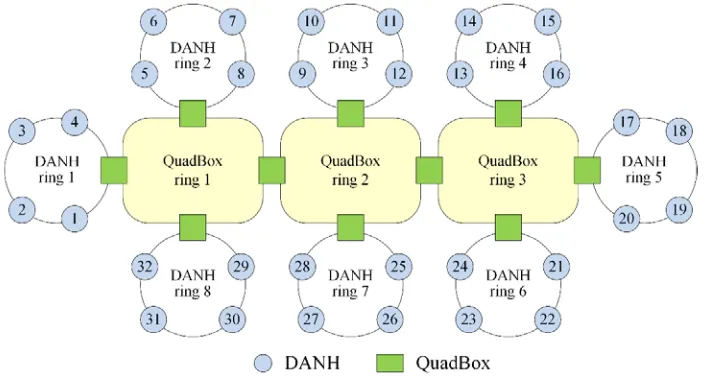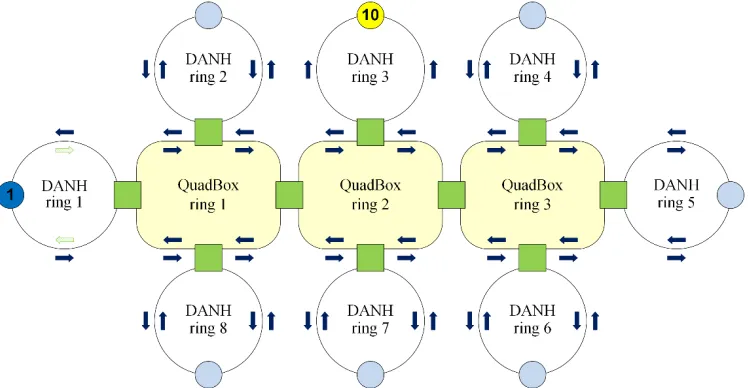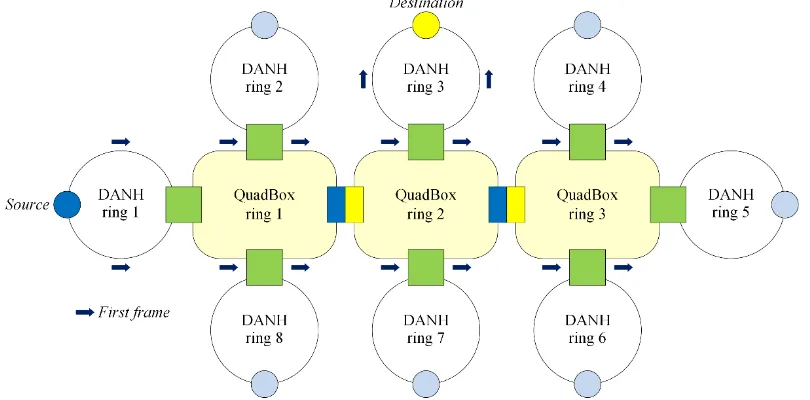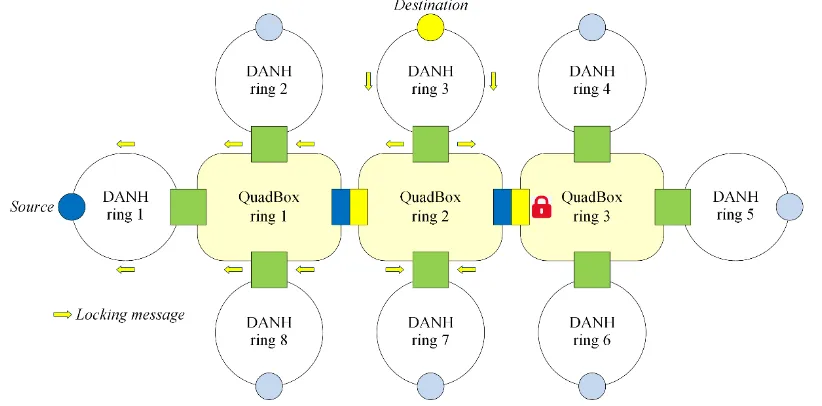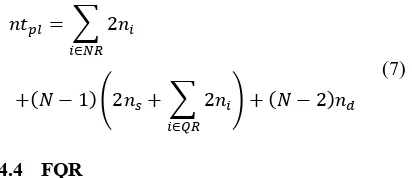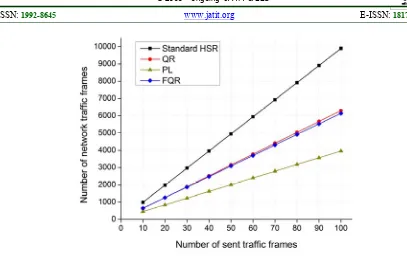1658
A NOVEL FILTERING TECHNIQUE FOR REDUCING
REDUNDANT UNICAST TRAFFIC IN HSR NETWORKS
1NGUYEN XUAN TIEN, 2JONG MYUNG RHEE, 3,*SANG YOON PARK
1Assistant Professor, Myongji University, Department of Information and Communication Engineering,
Yongin, South Korea
2Professor, Myongji University, Department of Information and Communication Engineering, Yongin,
South Korea
3Assistant Professor, Myongji University, Department of Electronic Engineering, Yongin, South Korea
*Corresponding author
E-mail: 1tiennguyen@mju.ac.kr, 2jmr77@mju.ac.kr, 3sypark@mju.ac.kr
ABSTRACT
High-availability seamless redundancy (HSR) is one of the seamless redundancy protocols providing tolerance for Ethernet networks. HSR is very useful for applications that demand high availability with fault-tolerance. However, redundant unicast traffic is excessively generated in HSR networks. This drawback causes high consumption of network bandwidth and may degrade network performance in HSR networks. In this paper, we propose a novel single-filtering technique called FQR that filters unicast frames for unused QuadBox rings in HSR networks. The FQR technique reduces duplicated unicast frames in an HSR network by filtering the frames for passive QuadBox rings that are not used to forward the unicast frames for a communication session between a source and a destination in the network. The FQR uses a simple mechanism to discover passive QuadBox rings and then prevent QuadBoxes from forwarding unicast frames into the passive QuadBox rings. By pruning unicast frames for passive QuadBox rings, the proposed technique dramatically decreases duplicated unicast frames in HSR networks compared to the standard HSR protocol. Traffic performance of FQR is analyzed and several simulations were carried out to validate the analysis. Numerical results showed that, for the sample network used in this paper, network unicast traffic under the proposed technique was reduced by 37% compared to that under the standard HSR protocol, resulting in the save of network bandwidth and the improvement of network traffic performance. The proposed single-filtering technique can be combined with other single-single-filtering techniques to propose a very effective combined-filtering technique for HSR networks.
Keywords: High-availability Seamless Redundancy (HSR) Protocol, Filtering Unicast Frames for Passive
QuadBox Rings, Traffic Reduction Technique, Fault-tolerant Communications, Smart Grids
1. INTRODUCTION
High-availability seamless redundancy (HSR) is a seamless redundancy protocol standardized in IEC 62439-3 [1] that provides the fault-tolerant capability for Ethernet networks. HSR is mainly designed for use in ring topologies, namely single-ring and connected-single-ring topologies. The operation of HSR is based on the duplication of every frame sent in a ring topology. A single-ring HSR network consists of doubly attached nodes for HSR protocol (DANHs); each DANH has two HSR ports. When a source DANH sends a unicast frame to a destination DANH in the ring, the source adds an HSR tag into the frame that is passed from its upper layers and
1659 Singly-attached nodes (SANs), such as maintenance laptops or printers, cannot be inserted directly into HSR rings. SANs communicate with HSR ring devices through a redundancy box (RedBox) that acts as a proxy for the SANs attached to it. In HSR connected-ring networks, DANH rings are connected to each other by using quadruple port devices (QuadBoxes). HSR is very suitable for systems demanding high availability with fault-tolerance, such as substation automation systems (SASs) and automation networks. HSR is one of the redundancy protocols used in SASs [4].
The main drawback of HSR is that it generates a lot of redundant unicast traffic in HSR connected-ring networks. The drawback is caused by the following issues:
1) Issue 1: Unicast frames are duplicated and
circulated in all rings, except the destination ring. 2) Issue 2: Unicast frames are forwarded into all
DANH rings.
3) Issue 3: Unicast frames are forwarded into all
QuadBox rings.
This drawback results in the high consumption of network bandwidth and the degradation of network performance. Several techniques have been proposed to reduce the redundant unicast traffic in HSR connected-ring networks, including traffic filtering techniques and dual paths techniques [5]. Traffic filtering techniques consist of single-filtering techniques, such as quick removing (QR) [6] and pork locking (PL) [7], and combined-filtering techniques, such as filtering HSR traffic (FHT) [8] and enhanced PL (EPL) [9]. Dual paths techniques include optimal dual paths (ODP) [10], dual virtual
paths (DVP) [11], ring-based dual paths (RDP) [12], and dual separate paths (DSP) [13].
Single-filtering techniques deal with one of the abovementioned HSR issues. The QR technique [6] prevents unicast frames from being circulated in rings, whereas the PL technique [7] filters unicast traffic frames for unused DANH rings. Most of existing single-filtering techniques solve HSR issues 1 and 2. However, there is no work that addresses HSR issue 3. In this paper, we propose a novel single-filtering technique called FQR to solve HSR issue 3. The proposed technique filters unicast frames for unused QuadBox rings called passive QuadBox rings in HSR networks. Therefore, the proposed FQR technique reduces redundant unicast frames in HSR networks.
The remainder of this paper is organized as follows. In Section 2, we briefly introduce existing single-filtering techniques. Next, in Section 3, we describe the proposed technique to filter unicast frames for passive QuadBox rings. Traffic performance of FQR is analyzed in Section 4, and several simulations and their results are described Section 5. The discussions are provided in Section 6. Finally, we conclude the paper and give our future work in Section 7.
2. RELATED WORK
[image:2.612.131.485.523.712.2]We consider an HSR connected-ring network that consists of eight DANH rings, each having four DANHs, as shown in Figure 1. In this sample network, QuadBoxes are used to interconnect DANH rings. Source DANH 1 in DANH ring 1 sends unicast frames to destination DANH 10 in DANH ring 3.
1660 Under the standard HSR protocol, when unicast frames are sent from the source DANH to the destination DANH, the frames are duplicated and circulated in all rings of the network, except the destination ring. The frames are not circulated in the destination ring because the destination does not forward the frames. The process of forwarding unicast frames under the standard HSR protocol is shown in Figure 2. It is clear that there is a lot of unicast traffic generated by the standard HSR protocol in the connected-ring network.
Several filtering techniques have been proposed to reduce the redundant unicast frames in HSR connected-ring networks. Filtering techniques can be sub-classified into two categories, including
single-filtering techniques and combined-filtering
techniques. The former are simple techniques that solve one of the HSR issues, whereas the latter usually combine some single-filtering techniques to address some or all of the HSR issues. There are two existing single-filtering techniques, namely the quick removing (QR) technique [6] and the port locking (PL) technique [7].
2.1 QR
QR is one of the simplest single-filtering approaches for reducing redundant traffic in HSR networks. QR reduces the redundant traffic by preventing traffic frames from being circulated in rings, including DANH rings and QuadBox rings. QR can be used in any topology and applied for any traffic.
The key idea of QR is that each HSR node forwards a unicast frame once, at most. When an HSR node receives an HSR frame, the node checks
if the unicast frame is received for the first time. If not, the node floods the HSR frame. If so, it discards the duplicated frame.
Figure 3 shows the process of forwarding a unicast frame under the QR technique.
2.2 PL
PL is a single-filtering technique that solves HSR issue 2 to reduce redundant unicast traffic in HSR networks. The PL technique does not forward HSR unicast frames into non-destination DANH rings that do not contain the destination DANH. PL is implemented on access QuadBoxes that connect to DANH rings. Each access QuadBox connects to two rings: a DANH ring and a QuadBox ring. PL divides each access QuadBox into two sides: the DANH side that connects to a DANH ring and the QuadBox side that connects to a QuadBox ring.
[image:3.612.121.498.519.713.2]When a source DANH sends a unicast frame to a destination DANH in an HSR network, the frame is forwarded into all DANH rings of the network. The frame is not circulated in the destination DANH ring because the destination DANH does not forward the frame. Otherwise, the frame is circulated in all non-destination DANH rings. The PL technique uses this mechanism to check and lock non-destination DANH rings. When an access QuadBox forwards a unicast frame into its DANH ring over one port and receives the sent frame through the other port connected to the same DANH ring, it means that the DANH ring is a non-destination DANH ring. The PL then locks DANH sides connecting to non-destination DANH rings in order to prevent the sides from forwarding unicast frames into the non-destination DANH rings.
1661 Figure 4 shows the process of forwarding a unicast frame under the PL technique.
As described above, the QR technique solves HSR issue 1, whereas the PL technique solves HSR issue 2. There is, however, no any single-filtering technique that is proposed to solve HSR issue 3. In this paper, the novel FQR technique is proposed to solve HSR issue 3.
3. THE PROPOSED FQR TECHNIQUE
The main idea of the proposed FQR technique is to prevent QuadBoxes from forwarding unicast frames into passive QuadBox rings that are not used
to deliver the frames from the source to the destination.
3.1 Concepts
There are two types of QuadBox used in the FQR technique, including access QuadBoxes and trunk QuadBoxes.
• An access QuadBox is a QuadBox that connects
to one DANH ring and one QuadBox ring.
• A trunk QuadBox is a QuadBox that connects
two QuadBox rings.
[image:4.612.97.520.69.291.2] [image:4.612.121.498.514.710.2]There are two types of DANH rings defined for a certain communication session, including a Figure 3: Forwarding a unicast frame under the QR technique
1662 destination DANH ring and non-destination DANH rings.
• The destination DANH ring contains the
destination DANH.
• Non-destination DANH rings are DANH rings
that do not contain the destination DANH. There are two types of QuadBox rings defined for a communication session, including active QuadBox rings and passive QuadBox rings.
• Active QuadBox rings are used to deliver unicast
frames from the source DANH to the destination DANH during the communication session.
• Passive QuadBox rings are not used to deliver the
frames during the communication session. The FQR technique is implemented at trunk QuadBoxes that used to connect two QuadBox rings. In the FQR technique, for a communication session, each trunk QuadBox is divided into two sides: the source side and the destination side, as shown in Figure 5.
• The source side is the side that is closer to the
source DANH.
• The destination side is the side that is closer to
the destination DANH.
The side types of trunk QuadBoxes are locally significant in each communication session.
3.2 Operations
The operation of the proposed FQR technique includes the following two phases: the side setting phase and the side locking phase.
3.2.1 Side Setting Phase
During the side setting phase, each trunk QuadBox checks and sets its sides to source side and destination side. This step is initiated when the source DANH starts to send the first unicast frame to the destination DANH. The first frame is forwarded into all rings of the network.
[image:5.612.179.434.363.472.2]Upon receiving the first frame, each trunk QuadBox sets the receiving side to the source side
[image:5.612.107.512.509.709.2]Figure 5: Source side and destination side of a trunk QuadBox
1663 and the other side to the destination side for the communication session, as shown in Figure 6.
3.2.2 Side Locking Phase
The process of discovering and locking passive QuadBox rings is performed in the side locking phase. When the destination DANH receives the first unicast frame, the destination DANH sends a control message called Locking message back to the source DANH. The control message is used to discover passive QuadBox rings.
Upon receiving the control message, each trunk QuadBox checks what type its receiving side is and then discovers the type of its QuadBox ring.
• If the receiving side is the destination side, the
QuadBox ring that the destination side connects to is an active QuadBox ring.
• If the receiving side is the source side, the
QuadBox ring that the destination side connects to is a passive QuadBox ring.
The Locking message is forwarded until it reaches the source. The control message, however, is not forwarded into passive QuadBox rings.
Finally, trunk QuadBoxes lock their destination sides that connect to passive QuadBox rings.
The process of discovering passive QuadBox rings is shown in Figure 7.
3.3 Forwarding Unicast Traffic
Under the FQR technique, when the first unicast frame sent by the source DANH is flooded into the entire network just as it is in the standard HSR
protocol. As from the second unicast frame, trunk QuadBoxes do not forward unicast frames into passive QuadBox rings.
The process of forwarding a unicast frame under the FQR technique is shown in Figure 8. In this case, QuadBox rings 1 and 2 are active QuadBox rings, whereas QuadBox ring 3 is a passive QuadBox ring for the communication session. Therefore, unicast frames of the communication session are not forwarded into QuadBox ring 3.
4. PERFORMANCE ANALYSIS
In this section, traffic performance of the proposed FQR technique is analyzed, evaluated, and compared with that of standard HSR protocols and two existing single-filtering techniques, including the QR technique and the PL technique.
The sample HSR connected-ring network shown in Figure 1 is used for the purpose of the network traffic performance analysis. We consider the communication session in that source DANH 1 in DANH ring 1 sends unicast frames to destination DANH 10 in DANH ring 3. In this case, DANH ring 3 is the destination DANH ring and the other DANH rings are non-destination DANH rings.
[image:6.612.105.516.508.711.2]In this paper, network traffic was chosen as a performance metric to analyze, evaluate, and compare the network traffic performance. Network traffic is defined as the total number of frame copies that travel on links and that are received by nodes in the network. When a unicast frame is sent from a source to a destination in a network, the network
1664 traffic is the total number of the frame’s copies that are delivered and received in the network.
4.1 Standard HSR
When the source DANH sends a unicast frame to the destination DANH, the frame is circulated in all rings, except the destination DANH ring, as shown in Figure 2.
Network traffic when the source DANH sends a unicast frame to the destination DANH under the
standard HSR protocol, denoted by , is
calculated as follows:
2 ∈
(1)
where is the number of nodes in the destination
DANH ring, is the number of nodes in the ith ring,
and is the collection of all rings, including
DANH rings and QuadBox rings.
Generally, network traffic when a source sends
unicast frames to a destination, denoted by , is
determined by:
2 ∈
(2)
4.2 QR
When the source DANH sends a unicast frame to the destination DANH, the QR forwards the frame into all rings and prevents the frame from being circulated in the rings, as shown in Figure 3.
Network traffic when the source DANH sends a unicast frame to the destination DANH under the QR
technique, denoted by , is calculated as follows:
1 ∈
(3)
Generally, network traffic when a source sends unicast frames to a destination in an HSR network,
denoted by , is determined by:
1 ∈
(4)
4.3 PL
When the source DANH sends the first unicast frame, the frame is circulated in all rings, except the destination ring.
Network traffic when the source DANH sends the first unicast frame to the destination DANH
under the PL technique, denoted by , is
calculated as follows:
2 ∈
(5)
When the source DANH sends the ( 2)
unicast frame to the destination DANH, PL does not forward the frame into non-destination DANH rings. However, the frame is still forwarded and circulated in all QuadBox rings, as shown in Figure 4.
Network traffic when the source DANH sends
[image:7.612.102.511.69.298.2]the ( 2) unicast frame to the destination
1665
DANH under the PL technique, denoted by , is
calculated as follows:
2 2
∈ (6)
where is the number of nodes in the source ring
and is the set of all QuadBox rings.
Generally, network traffic when a source DANH sends unicast frames to a destination DANH under
the PL technique, denoted by , is determined by:
2 ∈
1 2 2
∈
2
(7)
4.4 FQR
Under the FQR technique, when the source DANH sends the first unicast frame, the frame is forwarded and circulated in all rings, except the destination DANH ring.
Network traffic when the source DANH sends the first unicast frame to the destination DANH
under the FQR technique, denoted by , is
calculated as follows:
2 ∈
(8)
When the source DANH sends the ( 2)
unicast frame to the destination DANH, FQR does not forward the frame into passive QuadBox rings, as shown in Figure 8. In this communication session, QuadBox rings 1 and 2 are active QuadBox rings, whereas QuadBox rings 3 is a passive QuadBox ring.
Network traffic when the source DANH sends
the ( 2) unicast frame to the destination
DANH under the FQR technique, denoted by ,
is calculated as follows:
2 ∈
2
∈ (9)
where is the set of active QuadBox rings and
is the set of active DANH rings that connect to active QuadBox rings.
Generally, network traffic when a source DANH sends unicast frames to a destination DANH under
the FQR technique, denoted by , is determined
by: 2 ∈ 1 2 ∈ 2 ∈ (10)
5. SIMULATIONS AND RESULTS
To evaluate and validate the traffic performance analysis of the proposed FQR technique, several simulations were conducted using the OMNeT++ network simulator [14].
5.1 Simulation Description
We considered the sample HSR connected-ring network consisting of eight DANH rings and three QuadBox rings, as shown in Figure 1. Each HSR ring included four DANH nodes. QuadBoxes were used to connect DANH rings.
In the simulations, source DANH 1 in DANH ring 1 sent N (N = 10, 20, …, 100) unicast frames to
destination DANH 10 in DANH ring 3. The network traffic frames were recorded under the standard HSR protocol and single-filtering techniques to evaluate and compare the network traffic performance.
5.2 Simulation Results
Figure 9 shows a comparison of the network traffic performance between the FQR technique, the standard HSR protocol, and these existing single-filtering techniques.
The line graph in this figure illustrates the number of network traffic frames generated in the simulation network when the source DANH sent unicast frames to the destination DANH under the standard HSR protocol and single-filtering techniques, including the QR, PL, and FQR techniques. Overall, it can be seen from the graph that these single-filtering techniques significantly reduce network traffic in comparison to the standard HSR protocol. While the QR technique prevents unicast frames from being circulated in DANH and QuadBox rings, the PL and FQR techniques filter the unicast frames for non-destination DANH rings and passive QuadBox rings, respectively.
[image:8.612.91.297.241.330.2]1666 the save of network bandwidth and the improvement of network performance.
6. DISCUSSIONS
As mentioned in Section 1, the main drawback of HSR is the redundant unicast traffic in HSR networks that is caused by the three HSR issues. Several single-filtering techniques have been proposed to solve one of these HSR issues. Most of the existing single-filtering techniques focus on solving HSR issue 1 (the QR technique) and HSR issue 2 (the PL technique). However, there is no single-filtering technique that was proposed to solve HSR issue 3. In other words, there is no single-filtering technique that can filter redundant unicast traffic for passive QuadBox rings. In this paper, we proposed a novel single-filtering technique called FQR to address HSR issue 3.
While the existing single-filtering techniques including QR and PL focus on removing circulated traffic in rings and filtering unicast traffic for non-destination DANH rings, the FQR technique filters unicast traffic for passive QuadBox rings. The network traffic performance of these single-filtering techniques depends on the topology of HSR networks.
The proposed single-filtering technique (FQR) can be combined with the existing single-filtering techniques (QL and PL) to propose a very efficiently combined-filtering approach that solves all issues of
the standard HSR protocol and dramatically reduces the redundant unicast traffic in HSR networks.
7. CONCLUSIONS
In this paper, we proposed a novel single-filtering technique called FQR for filtering network unicast frames for passive QuadBox rings. The proposed FQR technique filters unicast frames for unused QuadBox rings based on discovering and locking destination sides of trunk QuadBoxes that connect to passive QuadBox rings in the communication session. By preventing unicast frames from being forwarded into passive QuadBox rings, FQR significantly decreases unicast traffic frames in HSR networks compared to the standard HSR protocol. Numerical results showed that, for the sample simulation network, the FQR technique reduced network unicast frames by 37% in comparison to the standard HSR protocol.
Our future work is to propose a combined-filtering approach that combines the newly proposed technique with other single-filtering techniques in order to solve all the HSR issues and effectively improving the network traffic performance for HSR networks.
ACKNOWLEDGMENTS
This research was supported by Basic Science Research Program through the National Research Foundation of Korea (NRF) funded by the Ministry
[image:9.612.93.500.63.319.2]of Science and ICT (grant number:
1667
2017R1A2B4003964) and the INNOPOLIS
Foundation funded with a grant in aid from the Korean government through MPEES Co., Ltd. and Myongji University (No: 1711046088).
REFRENCES
[1] IEC 62439-3, “Industrial Communications
Networks: High-Availability Automation
Networks, Part 3: Parallel Redundancy Protocol
(PRP) and High-Availability Seamless
Redundancy (HSR)”, IEC Standard, 2012.
[2] H. Kirrmann, K. Weber, O. Kleineberg, H. Weibel, “HSR: Zero recovery time and low-cost redundancy for Industrial Ethernet (High availability seamless redundancy, IEC 62439-3)”, In Proceedings of the 2009 IEEE Conference on Emerging Technologies & Factory Automation (ETFA2009), Mallorca, Spain, 22– 25 September 2009, pp. 1–4.
[3] H. Kirrmann, O. Kleineberg, “Seamless and low-cost redundancy for Substation Automation
Systems (High availability Seamless
Redundancy, HSR)”, In Proceedings of the Power and Energy Society General Meeting, Detroit, Michigan, USA, July 2011.
[4] IEC 61850-90-4, “Network Engineering Guidelines for Communication Networks and
Systems in Substations”, IEC Standard, 2013.
[5] N.X. Tien, S.A. Nsaif, J.M. Rhee, “A Comparison of Techniques for Reducing Unicast
Traffic in HSR Networks”, Energies, 8, 2015,
pp. 12029-12060.
[6] S.A. Nsaif and J.M. Rhee, “Improvement of High-Availability Seamless Redundancy HSR
Traffic Performance for Smart Grid
Communications”, Journal of Communications
and Networks, vol. 14, 2012, pp. 653–661.
[7] I.R. Abdulsalam and J.M. Rhee, “Improvement of high-availability seamless redundancy (HSR) unicast traffic performance using port locking”,
In Proceedings of 2013 Fourth World Congress on Software Engineering (WCSE2013), Hong
Kong, December 3–4, 2013, pp. 246–250. [8] N.X. Tien and J.M. Rhee, “FHT: A Novel
approach for filtering high-availability seamless
redundancy (HSR) traffic”, Energies, vol. 8,
2015, pp. 6249–6274.
[9] I.R. Altaha, J. M. Rhee, H.A. Pham, “Improvement of high-availability seamless redundancy (HSR) unicast traffic performance using enhanced port locking (EPL) approach”,
IEICE Transactions on Information and Systems,
E98-D, 2015, pp. 1646–1656.
[10] N.X. Tien, S.A. Nsaif, J.M. Rhee, “High-Availability Seamless Redundancy (HSR) traffic reduction using optimal dual paths (ODP)”, In Proceedings of the International Conference on Green and Human Information Technology, Da Nang, Vietnam, 4–6 February 2015, pp. 37–40. [11] S.A. Nsaif and J.M. Rhee, “DVP: A novel
high-availability seamless redundancy (HSR) protocol traffic reduction algorithm for a substation
automation system network”, Energies, vol. 7,
2014, pp. 1792–1810.
[12] N.X. Tien, S. Kim, and J.M. Rhee, “A novel ring-based dual paths approach for reducing redundant traffic in HSR networks,” Computer Networks, vol. 110, pp. 338–350, 2016.
[13] N.X. Tien, S. Kim, J.M. Rhee, and S.Y. Park, “A Novel Dual Separate Paths (DSP) Algorithm Providing Fault-Tolerant Communication for
Wireless Sensor Networks”, Sensors, vol. 17,
1699, 2017.
